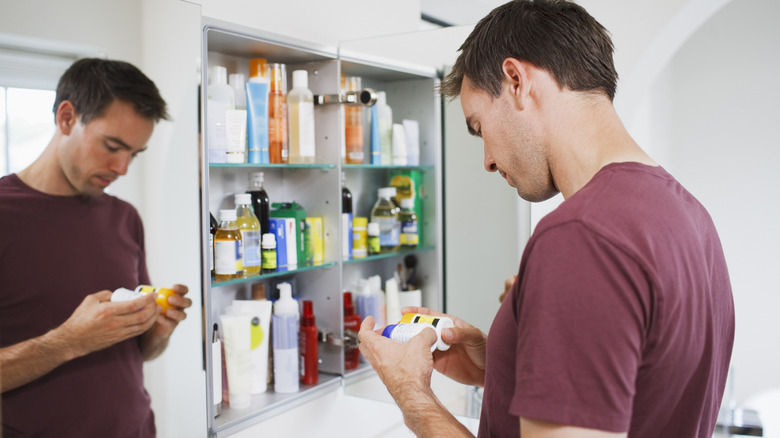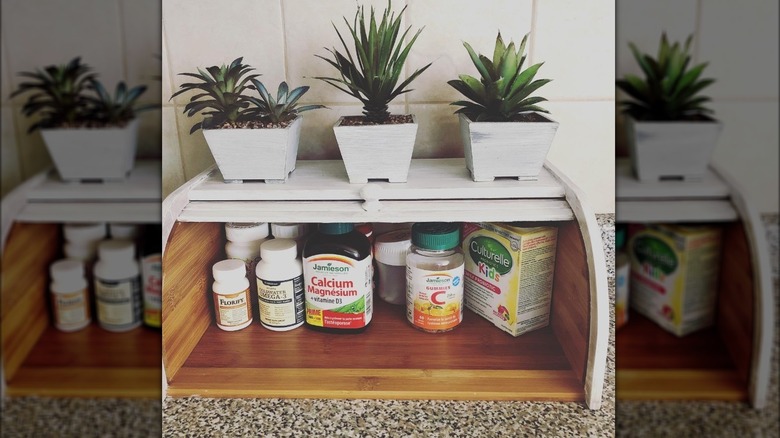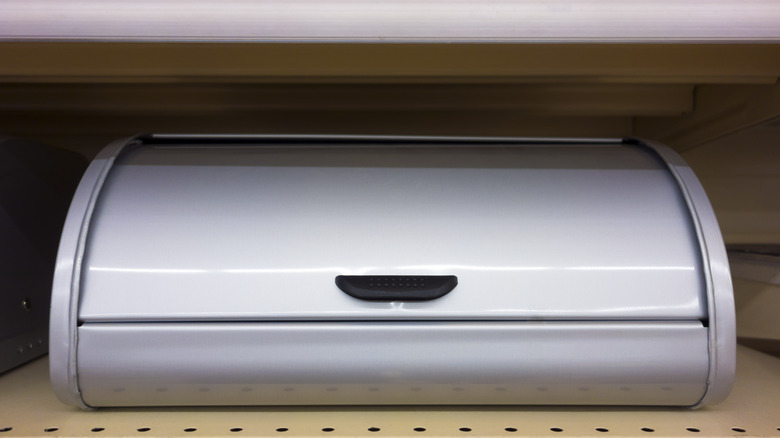Ditch The Dated Medicine Cabinet For This Stylish DIY
Are you ready to embrace a new medicine cabinet without the dated mirror look, but aren't sure what to use for storing your meds instead? If you don't mind rolling up your sleeves and taking on a repurposing job, the solution may just be hiding somewhere in your kitchen. We're talking about a bread box — one you no longer use to store loaves of bread, obviously. If you have one of these contraptions sitting around the house waiting for its turn at the next garage sale or recycling pickup day, don't be too fast to get rid of it. With a bit of elbow grease and creative flair, you can refashion it into a one-of-a-kind medicine cabinet in no time.
Repurposing a bread box is a great way to make a DIY medicine cabinet, because most of the work is already done for you. It's already a box that opens. Can it get any easier? All that's left for you to do is imbue it with a bit of character. You may choose to paint it if it's made from bamboo or plastic, or you might feel that a good cleaning or refinishing is all that's needed if the box is made of steel or an attractive wood. Whether your bread box is made of wood, steel, or plastic, here's how to breathe new life into it with a thorough cleaning and refinishing.
How to refinish an old wooden bread box
Bamboo and olive wood are common wood species used to make bread boxes. Telling the two apart should be relatively straightforward. Bamboo is light and generally has a subtle, narrowly spaced grain while olive wood is heavy, dense, and has a picturesque, wavy grain pattern.
If you're fortunate enough to unearth an olive wood bread box, please don't paint it. This expensive wood species is sought after worldwide specifically for its gorgeous appearance and unique, bold grain. Instead of hiding its natural beauty with paint, freshen the breadbox up by giving it a good sanding and new coats of stain and sealant. When sanding olive wood, take care not to scratch it. Start with a coarser grit, sand with the grain, and move up grit sizes as you work the wood to perfection. Manual sanding is the best option, since the kind of heat a powered sander produces can check (or split) olive wood. Wear a mask while sanding, since olive wood shavings are mildly toxic. Next, stain the wood if you like, then seal it; olive wood does particularly well with a wax or oil-based finish.
If you have a bamboo bread box, you can either paint it in a color of your choice, or stain it to preserve the natural look. Start by cleaning the wood, then sand it gently with a fine-grit sandpaper. If painting, use water-based dyes or paints, like acrylic or latex, and paint along the grain.
Refinishing metal and plastic bread boxes
If the bread box is made of steel, you have the option of cleaning its surface, or cleaning and painting it. Either way, cleaning is a necessary restorative step that will help you get rid of any accumulated grime. Start by soaking a microfiber cloth in warm water, then wiping the surface of the steel bread box along the metal's grain. Any rust you find should come off if you sand the affected area with a 120-160-grit sandpaper. Alternatively, WD-40 is a household staple that easily removes rust from stainless steel. Next, spray the box with a stainless steel cleaner, like this Weiman cleaner and polish from Amazon. Finally, rub the compound into the surface of the box with a microfiber cloth — again, never going against the grain to avoid leaving streaks. If freshening up the steel was your sole objective, then your brand-new medicine cabinet is ready to use. Now, if you prefer to slap a coat of paint onto the steel, do so after the cleaning and rust removal. For a glossy, scratch-resistant coating, use an alkyd-based paint; otherwise, acrylic paint will do just fine.
Plastic bread boxes may be a bit more challenging to paint, since paint doesn't bond well to its non-porous surface. However, it's still doable if you choose the right paint. For example, acrylic latex paints generally work well with polyethylene and polypropylene, while oil-based paints are a suitable match for polystyrene. To paint a more detailed, ornate pattern, use acrylic markers instead.


